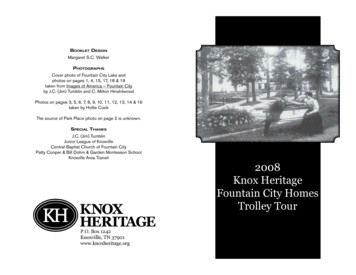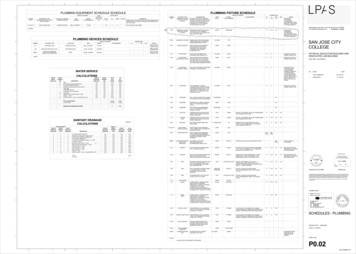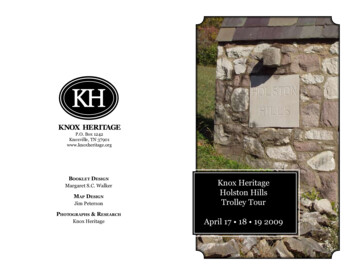
Transcription
Booklet DesignMargaret S.C. WalkerPhotographsCover photo of Fountain City Lake andphotos on pages 1, 4, 15, 17, 18 & 19taken from Images of America – Fountain Cityby J.C. (Jim) Tumblin and C. Milton HinshilwoodPhotos on pages 3, 5, 6, 7, 8, 9, 10, 11, 12, 13, 14 & 16taken by Hollie CookThe source of Park Place photo on page 2 is unknown.Special ThanksJ.C. (Jim) TumblinJunior League of KnoxvilleCentral Baptist Church of Fountain CityPatty Cooper & Bill Dohm & Garden Montessori SchoolKnoxville Area Transit2008Knox HeritageFountain City HomesTrolley TourP.O. Box 1242Knoxville, TN 37901www.knoxheritage.org
A Brief History of Fountain CityIn 1788, the State of North Carolina granted John Adair a 640-acresection of land in recognition of his services to his country. Landgrant No. 28 gave him one square mile of wilderness land in GrassyValley that extended from the present Fountain City Business Park tothe Gresham Junior High School campus.The city that would become Knoxville was born in 1786 when JamesWhite established White’s Fort on the banks of the Tennessee River(then called the Holston) between First and Second Creeks. It wasonly 2 years later that John Adair (1732–1827) established Fort Adairon his land just one mile south of the area that would become centralFountain City many years later.Adair’s Fort was designated a supply base for the CumberlandGuard, which was responsible for protecting settlers from NorthCarolina and Virginia as they moved toward the CumberlandSettlements at present-day Nashville. The fort stored corn, flour,pork, and beef to supply the families as they moved through thewilderness. The area was sparsely populated over its first century.Then Fountain Head Improvement Company received a charter givingit the right to develop a park and resort on July 1885. Stephensonand Getaz, architects and builders, drew up plans for a splendidhotel building three stories high with 40 to 50 rooms. Several guestcottages were planned and erected over the next few years. TheFountain Head Hotel, built overlooking the beautiful wooded park andcampgrounds, was ready for occupancy in the spring of 1886.Interest grew again when the Fountain Head Dummy Line madeits first run in 1890. As transportation became faster and easier,Knoxville businessmen first built summer residencies in FountainCity and later established year-round homes. Among those whobuilt permanent homes here were John W. Hope, jeweler; ColonelJ.C. Williams, coal magnate; W.T. Hall, clothier; and Sol George,department store owner.The Dummy Line made a stop at Smith’s (Smithwood), and the busyTazewell-Jacksboro Turnpike—a macadamized toll road—ran throughSmithwood and Beverly. With better access and transportation, thatarea developed faster than the area around the lake and the park.(continued on inside back cover)A Brief History of Fountain City, continuedThe George, McMillan, Caldwell, Kesterson, Anderson, Tillery,Conner, Rochat, and Truan families, among others, built on or nearTazewell Pike.A real estate boom developed in 1890, when Col. J.C. Woodwardof Lexington, Kentucky, and a group of capitalists bought 431 acresof land in Fountain Head at a cost of 159,600. They launched anextensive advertising campaign in the Knoxville newspapers stressingpure water, beautiful trees, and a pleasant climate, prompting anumber of new families to build homes around the Fountain HeadPark area.There was a lot happening in 1890 with the Dummy Line operating,the hotel open, and busy real estate sales. That same year, theUnited States Post Office was established, and the name changedto Fountain City to avoid confusion with another Tennessee towncalled Fountain Head in Sumner County.The resort season of 1891 is remembered as the best season everenjoyed by the Fountain Head Hotel. However, the Knoxville BlueBook (1894) listed only 70 permanent residents. No curative powerswere claimed for the water from the Fountain Head Spring, as wasthe case with several resorts with mineral springs all over EastTennessee. Regardless of that, some of Knoxville’s most prominentfamilies took advantage of the cool summer breezes, the hospitality,and the delicious 50-cent meals prepared by Mary Donahue.Holbrook College opened in 1893 with an enrollment of more than100 students and, by 1900, the central business district along HotelAvenue was being developed. Central High School purchased thebuilding and grounds of Holbrook College and opened there in1906. By 1940, there were 40 businesses along Broadway alone.Slow but steady growth continued until the population had reached30,000 by the time the suburb was annexed into the City of Knoxvillein 1962.Taken from Images of America—Fountain City by J.C. (Jim) Tumblinand C. Milton Hinshilwood
Fountain City Lake5300 North BroadwayIn 1890, Colonel J.C. Woodward and a group of Lexington,Kentucky, capitalists founded the Fountain Head Land Company.By 1891, the group had designed the lake and under thesupervision of Felix G. Phillips, a prominent local civil engineer,and had excavated, built the retaining walls, and impounded theheart-shaped lake.In the fall and winter of 1985 and 1986, the lake was drained andrefurbished. Currently, the Fountain City Lions Club maintainsthe lake.Park Place/Woodward-Williams House5101 BroadwayIn 1890, Colonel J.C. Woodward and a group of capitalists fromLexington, Kentucky, bought 431 acres at a cost of 159,600,plus the Fountain Head Hotel and the 14.1 acres surrounding it,including the park, for an additional 27,500. Colonel Woodwardbuilt his home in 1890 at a cost of 20,000 with the BaumannBrothers as architects and W.H. Dawn, Sr. as the contractor.In 1899, Woodard would build a home for his son Hu calledLakeview.Colonel Woodard served as president of Knoxville BusinessCollege and later become involved with a custom publishingcompany and a company called Southern Canopy Company. LaterPark Place was home to Matthew S. McClellan (1900–1909),Thomas Pruden, and J.C. Williams (1917–1980). The house wasdemolished in 1980 for a Target store.
Greenwood Cemetery3500 Tazewell PikeAdair Gardens Historic DistrictAdair Gardens was platted in 1920 as the Adair GardensSubdivision. Its western terminus on Broadway, the locationof streetcar tracks, and later bus lines, made it attractive as acommuter suburb.The houses for Adair Gardens were built for speculation andbuilding dates from early the 1920s into the early 1930s. Someof the many architectural styles in Adair Gardens include TudorRevival, Colonial Revival, and Neoclassical.Greenwood Cemetery was established by Dr. Reuben N. Kesterson(1858–1931) in 1900. When his first son Robert Neil (1887–1890)died from a childhood illness at age 3, Kesterson was so upset thathe took a year off from his dental practice to travel nationwideseeking a model for the cemetery that would be his son’s finalresting place. In 1900, Kesterson bought a 175-acre tract of landon Tazewell Pike and Greenwood Cemetery was established.Dr. Kesterson would relocate his son’s coffin to Greenwood fromOld Gray Cemetery. A memorial for the son was erected in 1928—a45-foot marble obelisk at his gravesite. At the time, the memorialwas the second largest in the country, second to the 65-footmemorial at the gravesite of a member of the Rockefeller family.The marble for the memorial was quarried and milled in Georgiaand shipped to Knoxville by rail and carried to the site by wagons.It is said that the monument was planned so it would be visiblefrom the upstairs dormer windows of the Kesterwood home,a half mile away at 5116 Kesterwood Road. Many prominentKnoxvillians are buried here, including James Agee’s father, EllenMcClung Berry and members of the McClung family, George S.Dempster, C.B. Atkins, and Sol H. George. Knoxville’s old familiesused the cemetery when Old Gray began to be overcrowded. Latergenerations of Knoxville families moved to Highland Cemetery onSutherland Avenue in the mid-to-late 20th century.
Dr. Charles L. Chumley Residence on Tazewell Pike4708 Tazewell PikeShannondale Presbyterian Church4600 Tazewell PikeDr. Charles L. and Marie Jones Chumley and their three children,Charles L. Jr., John, and Patricia, lived here. Dr. Chumley beganhis surgical practice in Knoxville in 1929 and became a pioneerin brain surgery in East Tennessee. John Chumley became aninternationally acclaimed artist with paintings in the permanentcollections in ten art museums and in the American Embassy inMoscow.Shannondale Presbyterian Church was built in 1886 byStephenson & Getaz soon after the congregation was established.Stephenson & Getaz advertised themselves as builders,contractors, and architects from 1886 until 1890. The firm wasactually established in 1882 as an architectural manufacturingcompany where shops were spread out over four buildings for themanufacturing of doors, window sashes, flooring, ceilings, weatherboard, brackets, molding, mantles, and seasoned lumber. With 32employees, it was thought to be one of the most extensive businessventures of its kind. Their venture into the field of architecturefollowed their success in winning the design competition for theKnox County Courthouse.
Kesterwood5116 Kesterwood RoadDr. Reuben N. Kesterson’s home, called Bedford Oaks, was builtin 1928 in Smithwood near the second Tazewell Pike entranceto Greenwood Cemetery. It is said that the dormer windows onthe home were built to permit a view of his son’s monument, atall obelisk about 1,000 yards away. Kesterson was born in NewTazewell on July 12, 1858. Educated in local Claiborne Countyschools and Mossy Creek Academy, Kesterson would go on toreceive his dental degree from the University of Louisville MedicalSchool Dental Department in 1883. Kesterson opened his firstoffice in Tazewell but, after a few years, moved his office toKnoxville in 1887. His office was in the East Tennessee NationalBank Building at 505 S. Gay Street. It is said that Dr. Kestersonwas the first college-educated dentist in Knoxville and becameone of the first deans of the Dental Department of the TennesseeMedical College, then located in Knoxville. It is also said thatKesterson bought one of the first Cadillac automobiles straightfrom the Detroit factory in 1903 and had the parts shipped toKnoxville and assembled. Dr. Kesterson died December 4, 1931.The house was later home to City Councilman, Howard Kesley.The John Humbard House3401 Kesterwood RoadThe Humbard house was built in 1919. John Humbard was a roadconstruction superintendent for projects on several continents.Some of his local projects included the road from Pigeon Forge toNewfound Gap (which is said to have been his most challengingproject) and included the Panamanian Trans-Isthmian Highway,the stone bridge over Linville Gorge, and the Blue Ridge Skywaybetween Blowing Rock and Linville, North Carolina. Humbardwas also in charge of the construction of the 1,563-mile AlaskanHighway from Fairbanks to Dawson, Alaska, and various projectsin Turkey, Central America, Costa Rica, Nicaragua, Puerto Rico,and the Virgin Islands.In 1951, Humbard was appointed Director of the ImperialEthiopian Highway Authority for a 9,000,000 road buildingproject.
Carlos Campbell House2837 Gibbs DriveGibbs Drive Historic DistrictOnce known as Jackson Boulevard, the first house to have beenconstructed on Gibbs Drive predates the subdivision. The 1910Colonial Revival house at 3047 Gibbs Drive was built on thecorner of Jackson (now Gibbs) and Jacksboro Pike. That sameyear, a group of real estate and mortgage company partners andinvestors had the land surveyed and subdivided. The subdivisionrestrictions required that only single family houses be built.Throughout the rest of the second decade of the 20th century,houses began to spring up along the new development. It isobvious that the automobile played an important role in GibbsDrive development, as evident in the number of garages that wereconstructed alongside or behind the houses. Architectural stylesfound along Gibbs Drive are bungalows and craftsman-influencedhouses; revival styles, including colonial, Dutch, and Tudor; andminimal traditional.The house at 2837 Gibbs Drive was built around 1916, and CarlosCampbell moved with his family to this house in 1922. Campbellwas one of the five individuals who had major roles in theestablishment of the Great Smoky Mountain National Park. Hewas also a founding member of the Smoky Mountain Hiking Club.Carlos Campbell co-authored the book Great Smoky MountainWildflowers, which is now expanded and revised and in itsfifth edition, and Birth of a National Park in the Great SmokyMountains, written in 1960 and reprinted three times.
Dempster-Francis House2805 Gibbs DriveSavage House and Gardens3237 Garden DriveThe Dempster-Francis House was built in 1924. George Dempsterlived in the house from 1929 until about 1933/34. Dempster lostthe house during the Great Depression when the property wasauctioned off. During the Depression, his construction companyand other business ventures went bankrupt.Savage Gardens were designed by Arthur Savage, who was knownas the “Father of Rock Gardening in Knoxville” The bungalowstyle house was built in 1914 and purchased by the Savages in 1917.Dempster would later become Knoxville’s city manager,councilman, and mayor from 1952 until 1956. He is best known asthe inventor of the Dempster Dumpster.Coal magnate Louis Francis lived in the house in the 1930’s, andhis daughter, Margaret Francis lived there until 2001.Savage Gardens contains many rare and beautiful plants, many ofwhich are unknown to the East Tennessee area. Savage created therock garden over many years, and this style of design was used tohighlight the many different varieties of plants. Some of the stonestructures designed were The Stone House (1926), Round WaterTower (c. 1926), Hexagonal Water Tower (1918), Oriental Pagoda(pump house) (1926), Stone walls (1921), and the Pools (c. 1921and 1926).Savage House and Gardens is currently owned by Bill Dohm andPatty Cooper and is the home of Garden Montessori School.
Judge John W. Green House – Ridgeview2945 Walkup DriveCharles J. McClung House – Ridgefield2910 Walkup DriveJudge John Green (1859–1957) built this house in 1922. It is aBarber & McMurry design. The Green family built their house onthe site of their first home, which was also called Ridgeview. Greenwas the Chairman of the Fountain City Park Commission for manyyears and was on the Knox County Library Board for 72 years.C.J. McClung (1866–1932) was a prominent businessman andwas partners with his brother Calvin M. McClung in the wholesalehardware business. Their company was called C.M. McClung andCompany.Green married Ellen Marshall McClung, daughter of Frank H.McClung—Knoxville merchant and descendent of Knoxvillefounder James White—and sister to Charles McClung. For manyyears, the Green’s permanent home was located on Laurel Avenuein Fort Sanders, and they would spend summers at Ridgeview.The house is now home to Dr. Joe Black, Jr., a well-known retiredpediatrician.The house was built on Black Oak Ridge in the Grove Parkaddition with a spectacular view of downtown Knoxville and theGreat Smoky Mountains. The house later became home to WilliamWalkup, the president of Home Federal Bank. The house iscurrently owned by Raymond M. Fuller.
Belcaro2000 Belcaro DriveBelcaro was home to Judge Hugh Lawson McClung (1858-1938).McClung, great grandson of James White, founder of Knoxville,was a member of the Board of Trustees of East TennesseeUniversity and built a large law practice with his brother-in-law,Major Thomas Webb. McClung also invested in real estate andcoal. McClung was one of the wealthiest men in Knoxville when heretired in 1908. In his later years, he bought land on top of BlackOak Ridge and built his home, Belcaro. James Chillman was thearchitect with Ralph E. Griswold as the landscape architect. Thereal driving force in the planning, design, and building of Belcarowas his daughter Ellen McClung. The house was completed in1922 at an estimated cost of 175,000. The house and gardenswere the site of the wedding of Ellen McClung to Thomas Berry in1928. While the house was Georgian Revival in style, the gardenswere inspired by Italian gardens, especially Villa Gamveria atSettignano near Florence. When McClung died in 1938, he left thehome to his wife and daughter. Ellen McClung Berry lived in ituntil she moved in 1953. The house was torn down in 1996 and anew house was built.Gresham Middle School(formerly Central High School)500 Gresham RoadWhen the new Central High School was built in 1971, the formerhigh school became Gresham Middle School, named for thevenerable principal of Central from 1919 to 1947, Hassie K.Gresham. Holbrook Normal College occupied the site from 1893to 1900.
Fountain Head Hotel100 Evergreen Lane(behind the Butcher Insurance Office)Finished in 1886, the Fountain Head Hotel was a popularattraction for day and overnight visits to the park and lake. Therewere about 50 rooms and lodging started at 2.00 per night.Not like any other hotel during this era, the Fountain Head Hotelhad a bathroom on each of the three floors with hot and coldrunning water. Meals were served for 50 cents, and an Italianband played every night. The band marched down the long stepsby the side of the spring to give concerts from the bandstand inthe park at 6:30 p.m. each night.The Woodward-Morgan-Gentry House/Gentry-Griffey Funeral Chapel5301 Fountain RoadColonel J.C. Woodward built Lakeview for his son Hu Woodward(1880–1950) sometime in the late 1800s. Some sources state thatthe house was built in 1890; tax records indicate the house wasbuilt in 1899. Woodward and his family, including Hu, wouldmove to 305 E. Fifth Avenue around 1903. Later in his adult life,Hu would split his time between his winter residence in WestPalm Beach, Florida, and his summer home in Montclair, NewJersey. Hu died in 1950 and was buried in Montclair. Today, thehome is extensively remodeled and much of the original houseremains as the core structure of the Gentry-Griffey FuneralChapel. Dr. Gideon H. Morgan bought the house around 1903.H.A. Rogers owned the house for a short time and then sold it toDover Williams (1874–1924) in 1917. Williams and his brotherJohn were owners of coal mines in Harlan and Coxton, Kentucky,and commuted back and forth on the train. The Williamsfamily lived in the house until 1943 when it was converted intoapartments. L. Glenard Gentry (1904–1971) bought the house in1948 and remodeled the structure into the current Gentry-GriffeyFuneral home.
The Fountain Head Railroad Company Stationa.k.a. “The Dummy Line”5315 Broadway at Hotel AvenueFountain City had excellent transportation provided by theDummy Line. It was built in 1889, and the first train startedrunning in 1890 and continued until 1905.The Dummy Line ran from Central Market (now Emory Park),and the northern terminus was “The Station” at Hotel Avenue andBroadway. The round trip took an hour and cost 15 cents (10 centsone way).Eventually, there were three engines, seven passenger cars, andfour freight cars. At its height, as many as 10,000 passengersrode the Dummy Line per day, from 5 a.m. until midnight. Thedowntown terminal was just north of Old Gray Cemetery.
Knox Heritage Fountain City Homes Trolley Tour Booklet Design Margaret S.C. Walker . Knoxville, TN 37901 www.knoxheritage.org. In 1788, the State of North Carolina granted John Adair a 640-acre . (then called the Holston) between First and Second Creeks. It was only 2 years later that John Adair (1732-1827) established Fort Adair .










